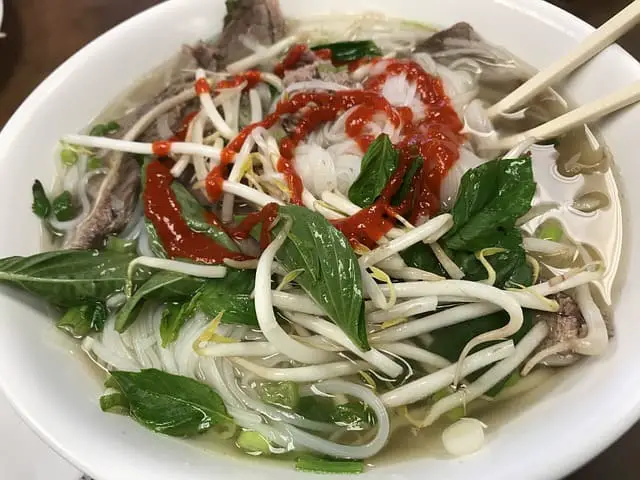Sriracha and Harissa are two popular condiments used in cooking but many people are unaware of the differences between them. While Sriracha is a liquid chili-based hot sauce squeezed from a bottle, Harissa is a spicy chili paste that can be spooned onto foods to increase the heat.
In this post, we will explore the differences between these two condiments in terms of how they are made, what they are made of, and what dishes to use them in.
Sriracha
Sriracha is a Thai-style hot sauce dating back to the 1940s that was introduced to the US in the 1980s and is sold in bottles. It’s made from chili peppers, vinegar, garlic, sugar, and salt. The ingredients are blended together and fermented for a period of time to create a smooth, slightly sweet, and tangy hot sauce.
Sriracha has a more straightforward sweet and tangy taste, with a smooth garlic and chili flavor, when compared to Harissa.
Sriracha is commonly used as a condiment in Asian cuisine, such as pho or ramen, or as a dipping sauce for sushi.
By comparison, hot sauces are generally made from vinegar and peppers and aren’t quite as layered as Sriracha.
5 ways you can use Sriracha
Sriracha can be squirted onto foods as desired. Here are some examples:
- As a condiment: Sriracha can be used as a condiment to add heat and flavor to a variety of dishes, such as sandwiches, tacos, eggs, and rice bowls.
- In marinades: Sriracha can be used as a marinade for meats, poultry, and seafood, adding a spicy and tangy flavor to the dish.
- In sauces: Sriracha can be used as a base or an ingredient in sauces, such as stir-fry sauces, BBQ sauces, and dipping sauces.
- In soups and stews: Sriracha can be added to soups and stews to add heat and flavor, especially in Asian-style soups such as pho or ramen.
- In dressings: Sriracha can be used to make spicy dressings for salads or coleslaw, adding a tangy and spicy kick to your greens.
Harissa
Harissa, on the other hand, is a spicy chili paste that originated in North Africa, particularly in Tunisia. It is made from a blend of chili peppers, garlic, olive oil, and spices such as coriander, cumin, and caraway seeds. Harissa has a thicker consistency compared to Sriracha, and it is often used as a condiment in Mediterranean and Middle Eastern cuisine. It can be used to flavor stews, soups, and sauces, or as a marinade for meat or vegetables.
In terms of flavor, Harissa has a more complex taste profile compared to Sriracha, with a strong earthy and spicy flavor from the spices used.
5 ways you can use Harissa
Harissa can be spooned onto foods as desired. Here are some examples:
- As a condiment: Harissa can be used as a condiment to add heat and flavor to a variety of dishes, such as sandwiches, tacos, eggs, and rice bowls.
- In marinades: Harissa can be used as a marinade for meats, poultry, and seafood, adding a spicy and earthy flavor to the dish.
- In sauces: Harissa can be used as a base or an ingredient in sauces, such as tomato sauces, dips, and spreads.
- In stews and soups: Harissa can be added to stews and soups to add heat and flavor, especially in Mediterranean and Middle Eastern-style dishes.
- In spice blends: Harissa can be used as an ingredient in spice blends for rubs, seasonings, and spices for meat and vegetables.
Final thoughts
Sriracha and Harissa are both delicious and versatile condiments that can add heat and flavor to a variety of dishes. While Sriracha is typically used in Asian cuisine, Harissa is used more in Mediterranean and Middle Eastern cuisine. When choosing between the two, it comes down to personal preference and the type of dish you are looking to make. Try both and see which one you prefer.
Sriracha and Harissa can certainly be used in place of one another but are different. Sriracha is a liquid that can be squirted onto foods whereas Harissa is a paste applied with a spoon. Sriracha and Harissa can be used on similar foods as we saw above.
To learn a bit more about Sriracha and Harissa, click here for an overview of Harissa and how it can be substituted if you don’t have any handy.

